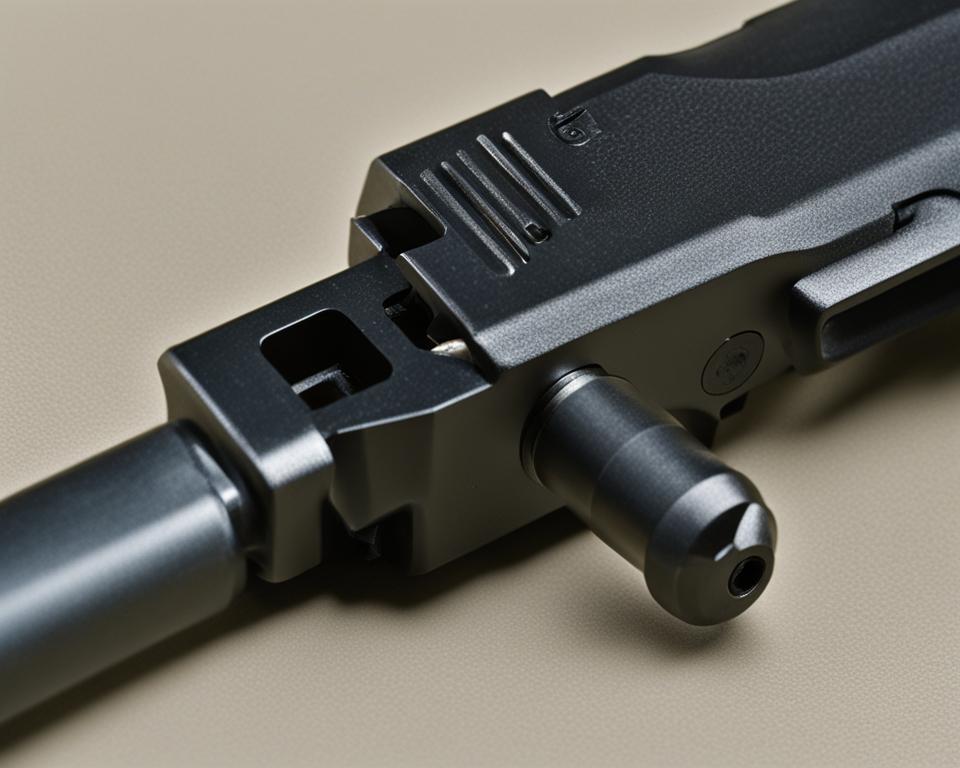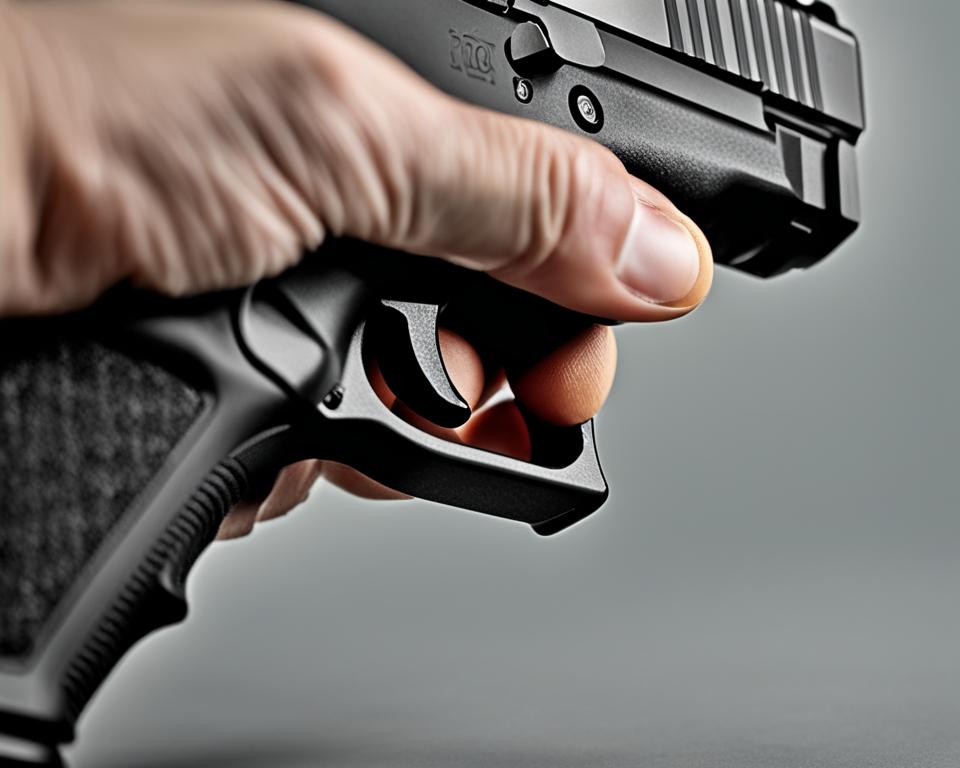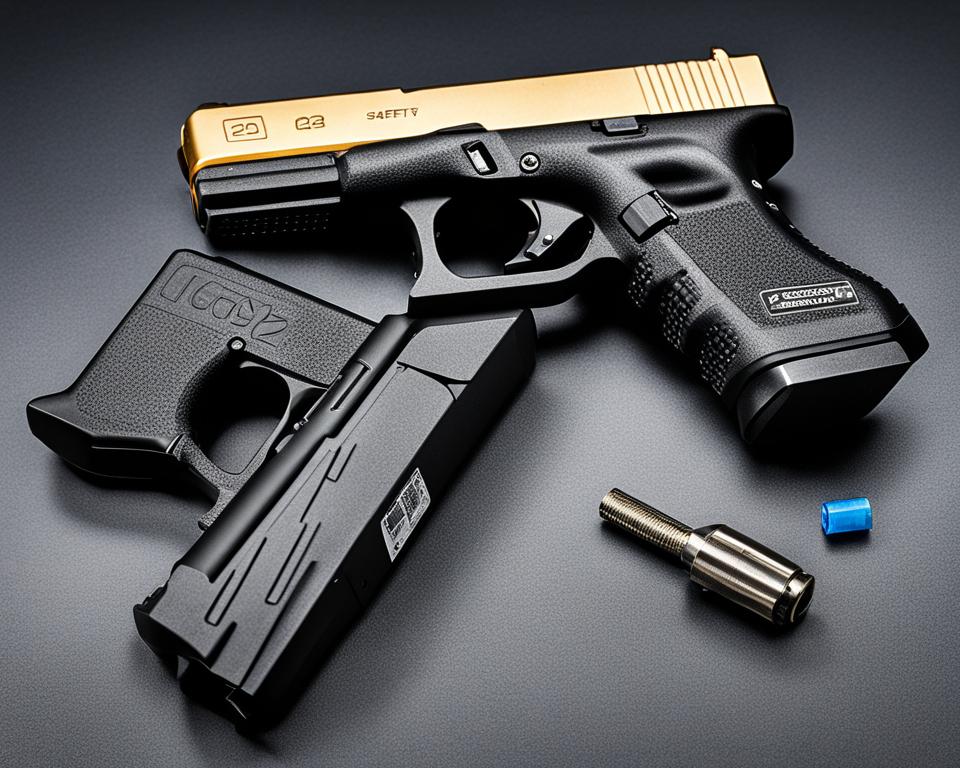When it comes to firearm safety, the Glock 26 is a top choice for responsible gun owners. This compact pistol is not only reliable and accurate but also equipped with advanced safety mechanisms that prioritize user security. In this article, we will explore the key safety features of the Glock 26 and how they contribute to a safer shooting experience.
The Glock 26 is built with the revolutionary SAFE ACTION® System, which ensures consistent trigger pull and includes three independently-operating mechanical safeties. These safety features work together to prevent accidental discharge and keep the pistol secure in various conditions and temperatures.
Key Takeaways:
- The Glock 26 is equipped with the SAFE ACTION® System, a revolutionary feature that enhances responsible handling and user security.
- The three main safety mechanisms of the Glock 26 include the trigger safety, firing pin safety, and trigger bar safety.
- The trigger safety blocks the trigger from moving rearward when engaged, preventing accidental firing.
- The firing pin safety mechanically blocks the firing pin from forward movement, ensuring it only moves when the trigger is pulled.
- The trigger bar safety engages the rear portion of the firing pin, preventing it from moving forward until the trigger is pulled.
The Trigger Safety
When it comes to firearm safety, the trigger safety of the Glock 26 plays a crucial role. Incorporated into the trigger itself, this safety feature takes the form of a lever that blocks the trigger from moving rearward when engaged. By requiring users to deliberately depress both the trigger safety and the trigger itself at the same time, this design ensures that the pistol will not fire if it is dropped or if the trigger is subjected to any unintended pressure.
The trigger safety serves as the first line of defense in the firing sequence of the Glock 26. Its purpose is to prevent accidental discharges and enhance user safety. This added layer of security is essential for responsible handling and provides peace of mind for firearm owners.
The Glock 26 trigger mechanism is meticulously crafted to prioritize safety without sacrificing performance. Understanding and using this safety feature correctly is essential for responsible gun ownership. By familiarizing oneself with the trigger safety function, users can confidently handle their Glock 26 pistols and ensure the highest level of safety at all times.
With the Glock 26 trigger safety mechanism in place, firearm enthusiasts can trust in the reliable performance and enhanced safety of their chosen weapon. In the next section, we’ll explore the firing pin safety, another integral component of the Glock 26’s safety systems.
The Firing Pin Safety
The firing pin safety is an integral component of the Glock 26’s safety system, playing a crucial role in preventing accidental discharges and ensuring user security. This safety mechanism is designed to mechanically block the forward movement of the firing pin when the pistol is in the ready-to-fire condition.
When the trigger is pulled rearward, the trigger bar exerts upward pressure on the firing pin safety, disengaging it and allowing the firing pin to travel forward. This enables the pistol to fire when the trigger is deliberately pulled.

However, if the user chooses not to fire and releases the trigger, the firing pin safety automatically reengages. This reengagement ensures that the firing pin remains securely blocked until the trigger is intentionally pulled again.
The firing pin safety of the Glock 26 enhances the overall safety of the firearm by providing an additional barrier against unintended or accidental firing. It is a critical feature that promotes responsible firearm handling and boosts the confidence of users.
Key Features of the Glock 26 Firing Pin Safety:
| Feature | Description |
|---|---|
| Mechanical Block | The firing pin safety physically blocks the forward movement of the firing pin. |
| Trigger Bar Engagement | As the trigger is pulled rearward, the trigger bar interacts with the firing pin safety, disengaging it to allow the firing pin to travel forward. |
| Automatic Reengagement | If the trigger is released without firing, the firing pin safety automatically reengages, ensuring the firing pin remains blocked until deliberately pulled again. |
The inclusion of the firing pin safety in the Glock 26’s design reflects the commitment of Glock to prioritize user safety. Combined with the other safeties present in the pistol, such as the trigger safety and the trigger bar safety, the firing pin safety functions harmoniously to provide robust protection and peace of mind to users.
The Trigger Bar Safety
The trigger bar safety is another integral component of the Glock 26’s safety mechanisms. Positioned within the trigger mechanism housing, it plays a crucial role in preventing accidental discharges and ensuring safe operation.
Resting on the safety ramp, the trigger bar safety engages the rear portion of the firing pin, effectively blocking its forward movement. This ensures that the firing pin remains secure and prevents any unintentional discharge of the pistol.
When the trigger is pulled rearward, the trigger bar lowers down the safety ramp, releasing the firing pin from its blocked position. This enables the firing pin to strike the primer, causing the firearm to fire. After firing, the trigger bar moves upward, reengaging the firing pin and restoring the pistol to its safe state, with the firing pin blocked once again.
It’s important to note that as the trigger is released, all the safeties, including the trigger bar safety, automatically reengage. This feature guarantees safe operation and provides an additional layer of protection against accidental discharges.

By incorporating this sophisticated trigger bar safety mechanism, Glock ensures that users can confidently handle the Glock 26, knowing that their safety is a top priority. The trigger bar safety, along with the other safeties, works seamlessly together to provide enhanced security and peace of mind.
Additional Safety Considerations
When it comes to owning and using a Glock 26, responsible firearm handling is of utmost importance. While the pistol is equipped with robust safety mechanisms, users must also take certain precautions to ensure safe operation.
First and foremost, proper training and familiarization with the Glock 26 is essential. Understanding how the safeties function and knowing the correct way to handle and operate the pistol can significantly minimize the risk of accidents. By attending certified firearms training courses or seeking guidance from experienced shooters, users can gain the necessary knowledge and skills to handle the Glock 26 safely.
Storing the Glock 26 securely when not in use is another critical consideration. Keeping the pistol in a locked safe or using a gun lock can help prevent unauthorized access, especially in households with children or individuals who are not trained in firearm handling. Responsible firearm owners understand the importance of properly securing their firearms to prevent any potential accidents or misuse.
Lastly, adhering to the basic principles of safe firearm handling is imperative. Always keep your finger off the trigger until you are ready to shoot and keep the muzzle pointed in a safe direction at all times. Treat every firearm as if it is loaded, even if you believe it is not. By following these simple guidelines, you can ensure that you are using the Glock 26 responsibly and maintaining a safe environment for yourself and those around you.
FAQ
What are the safety features of the Glock 26?
The Glock 26 is equipped with a trigger safety, firing pin safety, and a trigger bar safety that work together to enhance responsible handling and prevent accidental discharge.
How does the trigger safety in the Glock 26 work?
The trigger safety is a lever incorporated into the trigger that blocks it from moving rearward when engaged. Both the trigger safety and the trigger must be deliberately depressed at the same time to fire the pistol.
What is the purpose of the firing pin safety in the Glock 26?
The firing pin safety mechanically blocks the firing pin from moving forward when the pistol is in the ready-to-fire condition. It is disengaged when the trigger is pulled, allowing the firing pin to travel forward and strike the primer.
How does the trigger bar safety function in the Glock 26?
The trigger bar safety rests on the safety ramp within the trigger mechanism housing and prevents the firing pin from moving forward. When the trigger is pulled, the trigger bar releases the firing pin, allowing it to strike the primer. After firing, the trigger bar reengages the firing pin to ensure safe operation.
What are some additional safety considerations when using the Glock 26?
It is crucial to practice responsible firearm handling, undergo proper training, and familiarize yourself with the pistol’s safeties. Always store the pistol securely when not in use and adhere to the basic principles of safe firearm handling, such as keeping your finger off the trigger until ready to shoot and treating every firearm as if it is loaded.

Leave a Reply